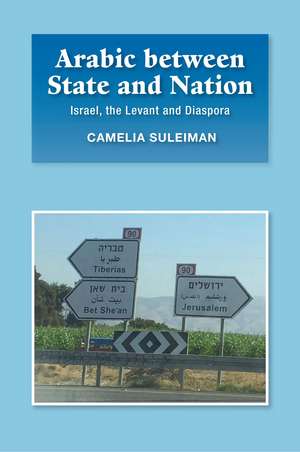Arabic between State and Nation: Israel, the Levant and Diaspora
Autor Camelia Suleimanen Limba Engleză Paperback – 31 oct 2022
Drawing on both ethnographic fieldwork and sociolinguistics, Arabic Between State and Nation analyzes the political conditions of Arabic in Israel. While linguists often treat Arabic speakers of the Levant as belonging to one dialect group, this book makes a novel contribution by studying the unique sociopolitical situation of the use of Arabic in the Jewish state, and particularly in East Jerusalem. That perspective is important in light of the removal of Arabic as an official language in Israel in 2018. The book’s study of Arabic in Israel is enhanced through comparisons to the political conditions of Arabic found in the Levant and among the Arabic-speaking diaspora in communities such as Dearborn, Michigan. These comparisons consider both large- and small-scale factors, ranging from the role of nation-state building to daily public usage of Arabic. Arabic Between State and Nation reaches far beyond linguistic differences to go to the heart of the political, social, and economic despair faced by multiple communities.
Preț: 440.07 lei
Preț vechi: 543.29 lei
-19% Nou
Puncte Express: 660
Preț estimativ în valută:
84.22€ • 91.45$ • 70.74£
84.22€ • 91.45$ • 70.74£
Carte tipărită la comandă
Livrare economică 22 aprilie-06 mai
Preluare comenzi: 021 569.72.76
Specificații
ISBN-13: 9781789761696
ISBN-10: 1789761697
Pagini: 240
Ilustrații: Maps, tables & circa 90 colour photos
Dimensiuni: 159 x 235 x 15 mm
Greutate: 0.29 kg
Editura: Sussex Academic Press
Colecția Sussex Academic Press
ISBN-10: 1789761697
Pagini: 240
Ilustrații: Maps, tables & circa 90 colour photos
Dimensiuni: 159 x 235 x 15 mm
Greutate: 0.29 kg
Editura: Sussex Academic Press
Colecția Sussex Academic Press
Notă biografică
Camelia Suleiman is an associate professor in the Department of Linguistics, Languages, and Cultures at Michigan State University. She is the author of The Politics of Arabic in Israel: A Sociolinguistic Analysis and Language and Identity in the Israel–Palestine Conflict: The Politics of Self-Perception in the Middle East.
Cuprins
Acknowledgements
List of Figures, Maps and Tables
Introduction
On Language, Identity and Conflict: Some Basic Concepts
A Word on Bilingualism, Code-switching and Language Loss
1.Can We Still Speak of a Levantine Arabic?
What is a Levantine Identity?
Dialect Boundaries and National Identity
The Linguistic Landscape
2. What is Happening to Arabic in Israel?
The Status of Arabic Post- 2018 Basic Nationality Law
The Linguistic Landscape
Arabic and Hebrew in Advertisements
Arabic Use in Social Media
3.Jerusalem, Al-Quds: Overview
Preamble
Discriminatory Laws that Make Life Hard for Arab Jerusalemites
Censorship
Arab Schools in Jerusalem
The ‘Tawjihi-Bagrut’ Controversy
Street Naming and the Linguistic Landscape
Let’s Start with the Name of the City
Interview with Yitshak Reiter (19 November 2019) on Street Naming in East Jerusalem, and Commentary
Neoliberalism Arrives in Jerusalem
4.Arabic in Jerusalem, Institutionally Speaking
Schools in East Jerusalem
Language Exchange
Jews Learning Arabic
Arab Women Learning Hebrew
Are We Witnessing a Social Movement?
The Hebrew University Opens its Gates to Arab Jerusalem
Arab Student Experience
Faculty Experience
‘Fear of Small Numbers’?
5.The (Il)Legitimacy of Arabic in Michigan: An American Linguistic Landscape
Demographic and Historic Background
Research on Arab Americans
The Linguistic Landscape
Stories of Dearborners
Conclusion
Index
